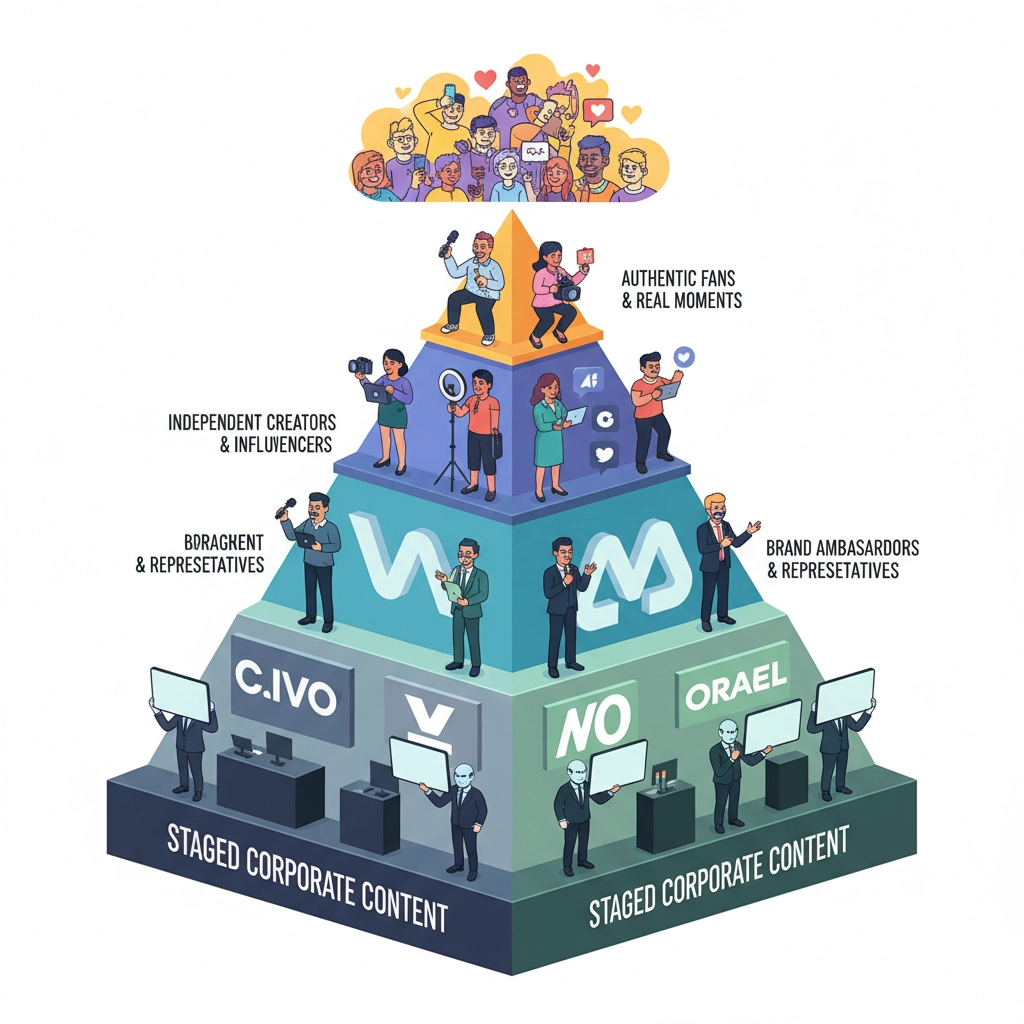The numbers don't lie: 84% of people trust brands more when they use user-generated content, and 93% of marketers admit that consumers trust UGC more than brand-generated content. In sports, this trust gap becomes even more pronounced as passionate fans seek authentic connections over polished marketing messages.
The Trust Statistics That Matter
User-generated content delivers 2.4 times more authenticity than branded content and proves 9.8 times more impactful than influencer posts. These aren't just marketing buzzwords – they represent a fundamental shift in how sports fans consume and trust content.
When 77% of people say UGC directly influences their purchasing decisions, sports brands need to pay attention. The trust advantage translates into real business results, especially in an industry built on passion and community.

UGC vs Professional Posts: A Side-by-Side Reality Check
Professional Post Example:
A perfectly lit stadium photo with professional editing, branded graphics, and promotional copy about upcoming games. Clean, polished, and clearly marketing-focused.
UGC Example:
A fan's shaky phone video from the bleachers, capturing the crowd's raw energy during a game-winning moment, with authentic excitement in their voice.
The difference is immediately clear. The professional post showcases the brand's capabilities, while the UGC post showcases real fan experience. Fans trust the second one because it comes from someone like them – no corporate agenda, just genuine enthusiasm.
Sports brands often struggle with this reality. Their beautifully crafted content gets fewer shares and less engagement than grainy fan videos because authenticity beats production value every time.
Why Fans Choose Raw Over Refined
The psychology behind UGC trust is simple: we trust people like us more than corporations. When a fan shares their game-day experience – complete with spilled nachos and genuine reactions – other fans see themselves in that content.
Professional sports content serves a purpose, but it can't replicate the peer-to-peer trust that UGC provides. Fans know that branded posts are designed to sell, while fan posts are designed to share excitement.
This trust factor becomes especially powerful in sports because fandom is inherently emotional. A fan wearing their team's jersey in a crowded stadium represents something money can't buy – authentic tribal belonging that other fans immediately recognize and trust.

Sports-Specific Trust Factors
Sports fan behavior differs from typical consumer behavior in key ways. Fans don't just buy products – they join communities. They don't just watch games – they live and breathe their teams' successes and failures.
This emotional investment makes fan-generated content incredibly powerful. When fans share content, they're not just posting – they're testifying to their authentic experience and inviting others into their passion.
Modern sports consumption patterns amplify this effect. Younger audiences especially consume sports content on mobile devices while simultaneously engaging on social media. They prefer user-generated video content over official league channels, often by a ratio of 10:1 in terms of volume.
The raw, unfiltered nature of fan content speaks directly to other fans' hearts in ways that corporate messaging simply cannot match. It's unscripted, unfiltered, and unsponsored – three qualities that build immediate trust.
Real Examples of UGC Trust in Action
Consider these scenarios:
Scenario 1: A sports equipment brand posts professional photos of their new cleats on a clean white background with perfect lighting.
Scenario 2: A high school athlete posts a photo of the same cleats after a muddy practice, explaining how they performed during actual game conditions.
Fans trust Scenario 2 because it provides genuine proof of product performance in real-world conditions. The first scenario showcases the product; the second scenario proves it works.
This pattern repeats across sports marketing. Fan reviews, game-day experiences, and training footage shared by real athletes carry more weight than any professional campaign because they provide unfiltered evidence of authentic experience.

Leveraging UGC on Fanz.us and Social Platforms
The key to success lies in turning fans into content creators rather than just consumers. Sports brands need strategies that encourage and amplify fan-generated content rather than competing with it.
On platforms like Fanz.us, this means creating spaces where fans can easily share their experiences, connect with other fans, and build communities around shared interests. The platform's social-first approach aligns perfectly with UGC strategies because it prioritizes authentic fan connections over corporate messaging.
Successful UGC strategies focus on:
Community Building: Create hashtags, challenges, and campaigns that encourage fans to share their experiences while wearing or using your products.
Real-Time Engagement: Respond to and share fan content during live events, games, and sporting moments when emotions run highest.
Authentic Partnerships: Work with real fans and amateur athletes who genuinely use and love your products, rather than relying solely on professional endorsements.
User-Friendly Sharing: Make it easy for fans to create and share content by providing simple tools, clear guidelines, and incentives for participation.
The Content Authenticity Hierarchy
Not all UGC is created equal. The trust hierarchy flows like this:
- Authentic UGC: Spontaneous fan posts with no brand involvement
- Creator Content: Influencer-generated content with disclosed partnerships
- Brand Content: Professional marketing materials
- Staged UGC: Paid content designed to look user-generated
Fans can spot staged UGC from a mile away, which is why 90% of consumers consider authenticity a critical component when evaluating content credibility. The goal isn't to trick fans into thinking corporate content is user-generated – it's to create an environment where authentic fan content thrives.

Measuring UGC Success in Sports
Traditional marketing metrics often fail to capture UGC's true value. Instead of focusing solely on reach and impressions, sports brands should measure:
Trust Indicators: Comments, shares, and saves that indicate genuine engagement rather than passive consumption
Community Growth: New followers who discovered your brand through fan-shared content
Conversion Quality: Purchases made by users who interacted with UGC versus traditional advertising
Content Velocity: How quickly fan content spreads compared to branded posts
Authentic Engagement: Meaningful conversations in comments rather than generic reactions
These metrics better reflect UGC's trust-building power and long-term brand value creation.
The Future of Sports Content Trust
The trust gap between UGC and professional content will likely continue growing as fans become more sophisticated about identifying authentic versus manufactured content. Sports brands that embrace this reality and build strategies around fan-generated content will maintain stronger connections with their audiences.
The most successful sports brands won't try to replace fan content with professional alternatives – they'll amplify and support fan voices while maintaining their own branded presence. This approach builds trust by demonstrating respect for fan perspectives and genuine community investment.
Platforms like Fanz.us represent the future of sports social media because they prioritize authentic fan connections over corporate broadcasting. As these platforms grow, the importance of user-generated content will only increase, making trust-building through authentic fan voices more critical than ever for sports brand success.
The message is clear: fans trust other fans more than they trust brands. Smart sports organizations will build their content strategies around this fundamental truth rather than fighting against it.
